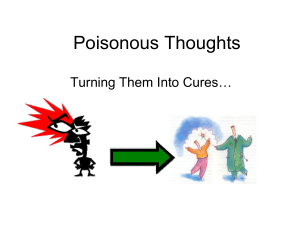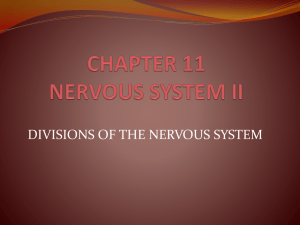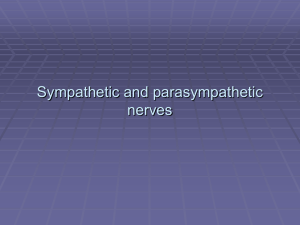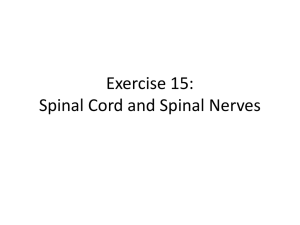Nervous System Jeopardy
advertisement
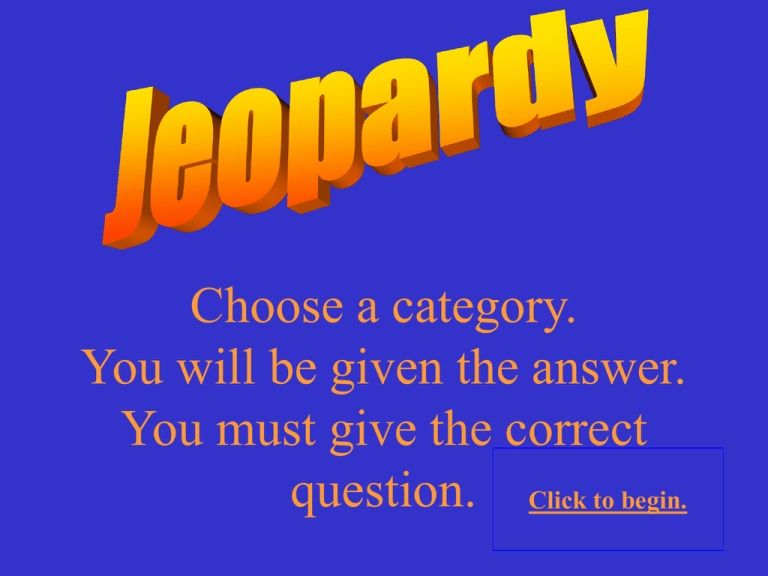
Choose a category. You will be given the answer. You must give the correct question. Click to begin. Click here for Final Jeopardy CNS Neurons Nerve Impulse PNS/ Autonomic Anything Goes 10 Point 10 Point 10 Point 10 Point 10 Point 20 Points 20 Points 20 Points 20 Points 20 Points 30 Points 30 Points 30 Points 30 Points 30 Points 40 Points 40 Points 40 Points 40 Points 40 Points 50 Points 50 Points 50 Points 50 Points 50 Points CNS refers to…? Brain and Spinal Cord Regulates body temperature, water balance and metabolism Hypothalamus Provides involuntary coorination of body movements, balance cerebellum What are the three major parts of the brain stem? Midbrain Pons Medulla oblongota Primary motor area, sends impulses to skeletal muscle Frontal Lobe Gap between two communicating neurons a. Effector b. Schwann cell c. Synaptic cleft d. Node of Ranvier Synaptic cleft Schwann cell forms a myelin sheath around the: a. Axon b. Dendrites c. Cell body d. nucleus axon A neuron with a cell body located in the CNS whose primary function is connecting other neurons: a. Glial cell b. Afferent neuron c. Association neuron d. Efferent neuron association The neuron process that normally receive incoming stimuli are called: a. Neurolemmas b. Dendrites c. Satellite cells d. axons dendrites Collection of nerve bodies outside the CNS a. Nerves b. Ganglia c. tracts d. Tracts or ganglia ganglia Impulse conduction is fastest in neurons that are: a. Myelinated b. Unmyelinated c. Sensory d. motor myelinated Which of the following is the correct sequence in a typical reflex arc: a.Receptor, afferent neuron, efferent neuron, integration center, effector b.Receptor, efferent neuron, integration center, afferent neuron, effector c.Receptor, afferent neuron, integration center, efferent neuron, effector d.Effector, afferent neuron, integration center, efferent neuron, receptor Receptor, afferent neuron, integration center, efferent neuron, effector A substance that is released at axonal endings to propagate a nervous impulse neurotransmitter An action potential: a. Is initiated by potassium ion movements b. Is essential for nerve impulse propagation c. Involves the outflux of negative ions to depolarize the membrane d. Involves the influx of negative ions to depolarize the membrane Is essential for nerve impulse propagation Put the following in the correct order of what occurs following the threshold potential 1. Membrane becomes depolarized 2.Membrane becomes repolarized 3.Sodium channels open and sodium ions diffuse inward 4.Potassium channels open and potassium ions diffuse outward while sodium is actively transported out of the cell 1. Sodium channels open and sodium ions diffuse inward 2. Membrane becomes depolarized 3.Potassium channels open and potassium ions diffuse outward while sodium is actively transported out of the cell 4.Membrane becomes repolarized The PNS includes: A. The brain and spinal cord B. Spinal nerves only C. Cranial nerves only D. Both spinal and cranial nerves d. Spinal and cranial nerves The sympathetic and parasympathetic nervous system are subdivisions of what? Autonomic nervous system Preparing body for “fight or flight” during threatening situations is the role of what subdivision of autonomic nervous system? sympathetic Which of these effectors is NOT directly controlled by the autonomic nervous system? a. Abdominal organs b. Most glands c. Cardiac muscle d. Skeletal muscle e. Smooth muscle skeletal Which of the following effects is characteristic of the parasympathetic nervous system? a.Decrease urine output b.Increase metabolic rate c.Decreases heart rate d.Decreases activity of the digestive system Decrease heart rate Afferent nerves are called ______, and motor nerves are called _______ a. Mixed nerves: motor nerves b. Motor nerves; sensory nerves c. Sensory nerves; efferent nerves d. Peripheral nerves; cranial nerves Sensory; efferent The elevated ridges of tissue on the surface of the cerebral hemishperes are known as ____ while the shallow grooves are termed _____ a. Ganglia; gyri b. Sulci; gyri c. Gyri; sulci d. Receptors; effectors Gyri; sulci Which one of the following is the correct sequence of nerves that exit the spinal cord, going from superior to inferior: a. Cervical spinal nerves, thoracic spinal nerves, lumbar spinal nerves, sacral spinal nerves b. Cervical spinal nerves, thoracic spinal nerves, sacral spinal nerves, lumbar spinal nerves c. Thoracic spinal nerves, cervical spinal nerves, lumbar spinal nerves, sacral spinal nerves d. Thoracic spinal nerves, cervical spinal nerves, sacral spinal nerves, lumbar spinal nerves a. Cervical spinal nerves, thoracic spinal nerves, lumbar spinal nerves, sacral spinal nerves Which of the following is a traumatic brain injury: a. CVA b. Parkinson’s disease c. Cerebral edema d. Alzheimer’s disease Cerebral edema The cerebrospinal fluid: a. Is secreted mostly by the ependymal cells lining the brain ventricles b. Enters the four ventricles after filling and circulating through the subarachnoid space c. Is continually formed mostly by the choroid plexuses d. Is identical in composition to whole blood Is continually formed mostly by the choroid plexuses Make your wager Match the following 1. 2. 3. 4. 5. Optic Oculomotor Vagus Trigeminal Glossopharyngeal a. b. c. d. e. Allows you to chew food Allows you to taste food Motor fiber for eye Sensory nerve for vision Promotes digestive activity 1. 2. 3. 4. Optic- sensory for vision Oculomotor- motor fiber for eye muscle Vagus- promotes digestive activity Trigeminal- allows you to chew your food 5. Glossopharyngeal- allows you to taste your food

